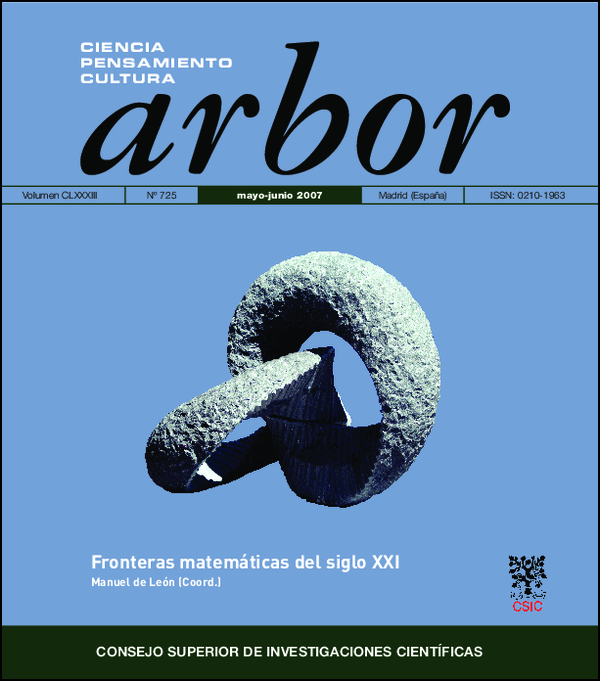Las matemáticas de la seguridad
DOI:
https://doi.org/10.3989/arbor.2007.i725.114Palabras clave:
Códigos correctores de errores, criptografía, información digital, clave pública, clave secretaResumen
El objetivo del trabajo es mostrar el papel esencial que juegan actualmente las matemáticas en la teoría de la información. El trabajo está pensado para no especialistas y pretende dibujar en unas breves pinceladas como es la situación actual.
Descargas
Citas
[1] M. Ajtai y C. Dwork, A public-key cryptosystem with worst-case/average case equivalente. Proc. of 29th STOC, ACM. 1997, 284-293.
[2] M. Bellare, A. Desai, D. Pointcheval y P. Rogaway, Relations Among Notions of Security for Public-Key Encryption Schemes Proc. of CRYPTO ’98, LNCS 1462, 1998, 26-45.
[3] D. Boneh y G. Durfee, Cryptanalysis of RSA with private key less than nº,292, Proc. of Eurcrypt’99, Lecture Notes in Computer Science 8494, 1999, 1-11. doi:10.1007/3-540-48910-X_1
[4] I. Cascudo, Aplicaciones de Retículos en Criptología. Tesina de Licenciatura, Universidad de Oviedo, 2006.
[5] D. Copperstmith, Small solutions to polynomial equations and low exponent RSA vulnerabilities. Journal of Cryptology 10(4), 1997, 233-260. doi:10.1007/s001459900030
[6] D. Copperstmith, Finding small solutions to small degree polynomials. Proc. of Cryptography and Lattices Conference’01, Lecture Notes in Computer Science 2146, 2001.
[7] D. Copperstmith y A. Shamir, Lattice attacks on NTRU. Proc. of Eurocrypt’ 97, Lecture Notes in Computer Science 1238, 1997, 52-61. doi:10.1007/3-540-69053-0_5
[8] R. Cramer y V. Shoup, A Practical Public Key Cryptosystem Provably Secure against Adaptive Chosen Ciphertext Attack Proc. of CRYPTO’98. LNCS, vol. 1162., 1999, 13-25.
[9] R. Cramer y V. Shoup, Universal Hash Proofs and a Paradigm for Adaptive Chosen Ciphertext Secure Public-Key Encryption Cryptology e Print Archive: Report 2001/085, 2001, 1-62.
[10] W. Diffie y M. E. Hellman, New directions in Cryptology. IEEE Trans. Information Theory 22, 1976, 644-654. doi:10.1109/TIT.1976.1055638
[11] O. Goldreich, S. Goldwasser y S. Halevi, Public-key cryptosystems from lattice reduction problems. Proc. of Crypto’97, Lecture Notes in Computer Science 1294, 1997, 112-131. doi:10.1007/BFb0052231
[12] O. Goldreich. S. Goldwasser y S. Halevi, On the limits of non-approximitability of lattice problems. Proc. of 80th STOC, ACM, 1998.
[13] S. Golwasser, New directions in Cryptography: Twenty some years latter (or a Match Made in Heaven), Proc. of the 88th Annual IEEE Symposium on Foundations of Competer Science, FOCS’97, 1997, 314-324.
[14] S. González, M. I. González-Vasco y C. Martínez, Esquemas de cifrado basados en grupos: pasado y futuro CD: Tendencias actuales en la Criptología, Sesión especial de MAT.es 2005 ISBN: 84-689-0117-2.
[15] M. I. González-Vasco. Criptosistemas basados en Teoría de grupos. Tesis Doctoral, Universidad de Oviedo, 2000.
[16] M. I. González Vasco, C. Martínez, R. Steinwandt y J. L. Villar, A new CramerShoup like methodology for group based probably secure schemes. Lecture Notes in Computer Science, Theory of Cryptography 3378, 2005, 495-509.
[17] A. J. Lenstra, H.W. Lenstra y L. Lovász, Factoring polynomials with rational coefficients. Mathematische Annalen 261. 1982, 513-534. doi:10.1007/BF01457454
[18] N. Koblitz, Adgebraic Aspects of Cryptography, Springer 2004.
[19] R. Merkle y M. Hellman, Hiding information and signatures in trapdoor knapsacks. IEEE Transactions of Information Theory, IT-24(5), 1978, 525-530. doi:10.1109/TIT.1978.1055927
[20] P. Q. Nguyen, Cryptanalysis of the Goldreich-Goldwasser-Halevi cryptosystem. Lecture Notes in Computer Science 1666, 1999, 288-304.
[21] P. Q. Nguyen y J. Stern, Lattice reduction in cryptology: An update. Lecture Notes ira Computer Science 1838, 2000, 85-112.
[22] P. Q. Nguyen y J. Stern, The two faces of lattice in cryptography. Lecture Notes in Computer Science 2146, 2001.
[23] C. E. Shannon, Communication theory of secrecy systems, Bell Syst. Tech. J. 18, 1949, 656-715.
Descargas
Publicado
Cómo citar
Número
Sección
Licencia
Derechos de autor 2007 Consejo Superior de Investigaciones Científicas (CSIC)

Esta obra está bajo una licencia internacional Creative Commons Atribución 4.0.
© CSIC. Los originales publicados en las ediciones impresa y electrónica de esta Revista son propiedad del Consejo Superior de Investigaciones Científicas, siendo necesario citar la procedencia en cualquier reproducción parcial o total.
Salvo indicación contraria, todos los contenidos de la edición electrónica se distribuyen bajo una licencia de uso y distribución “Creative Commons Reconocimiento 4.0 Internacional ” (CC BY 4.0). Consulte la versión informativa y el texto legal de la licencia. Esta circunstancia ha de hacerse constar expresamente de esta forma cuando sea necesario.
No se autoriza el depósito en repositorios, páginas web personales o similares de cualquier otra versión distinta a la publicada por el editor.














